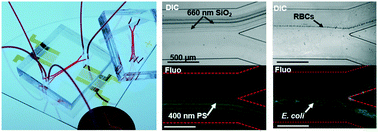A disposable acoustofluidic chip for nano/microparticle separation using unidirectional acoustic transducers†
Abstract
Separation of nano/microparticles based on surface acoustic waves (SAWs) has shown great promise for biological, chemical, and medical applications ranging from sample purification to cancer diagnosis. However, the permanent bonding of a microchannel onto relatively expensive piezoelectric substrates and excitation transducers renders the SAW separation devices non-disposable. This limitation not only requires cumbersome cleaning and increased labor and material costs, but also leads to cross-contamination, preventing their implementation in many biological, chemical, and medical applications. Here, we demonstrate a high-performance, disposable acoustofluidic platform for nano/microparticle separation. Leveraging unidirectional interdigital transducers (IDTs), a hybrid channel design with hard/soft materials, and tilted-angle standing SAWs (taSSAWs), our disposable acoustofluidic devices achieve acoustic radiation forces comparable to those generated by existing permanently bonded, non-disposable devices. Our disposable devices can separate not only microparticles but also nanoparticles. Moreover, they can differentiate bacteria from human red blood cells (RBCs) with a purity of up to 96%. Altogether, we developed a unidirectional IDT-based, disposable acoustofluidic platform for micro/nanoparticle separation that can achieve high separation efficiency, versatility, and biocompatibility.



 Please wait while we load your content...
Please wait while we load your content...